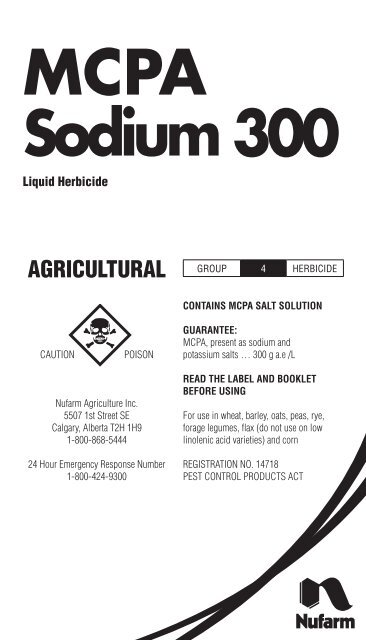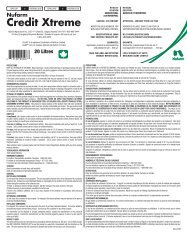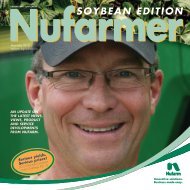Create successful ePaper yourself
Turn your PDF publications into a flip-book with our unique Google optimized e-Paper software.
<strong>MCPA</strong><br />
<strong>Sodium</strong> <strong>300</strong><br />
Liquid Herbicide<br />
AGRICULTURAL<br />
CAUTION POISON<br />
<strong>Nufarm</strong> Agriculture Inc.<br />
5507 1st Street SE<br />
Calgary, Alberta T2H 1H9<br />
1-800-868-5444<br />
24 Hour Emergency Response Number<br />
1-800-424-9<strong>300</strong><br />
GROUP 4 HERBICIDE<br />
CONTAINS <strong>MCPA</strong> SALT SOLUTION<br />
GUARANTEE:<br />
<strong>MCPA</strong>, present as sodium and<br />
potassium salts … <strong>300</strong> g a.e /L<br />
READ THE LABEL AND BOOKLET<br />
BEFORE USING<br />
For use in wheat, barley, oats, peas, rye,<br />
forage legumes, flax (do not use on low<br />
linolenic acid varieties) and corn<br />
REGISTRATION NO. 14718<br />
PEST CONTROL PRODUCTS ACT<br />
<strong>MCPA</strong> SODIUM <strong>300</strong>-E.indd 1 8/31/09 11:22 AM
PRECAUTIONS:<br />
KEEP OUT OF REACH OF CHILDREN. Avoid contact with skin, eyes and clothing. Wash<br />
concentrate from skin or eyes immediately. Do not inhale fumes. Avoid breathing spray<br />
mist. After use wash hands and other exposed skin. Avoid spray drift. Store the container<br />
tightly closed and away from seeds, feeds, fertilizer, plants and foodstuffs.<br />
Do not us in residential areas, which are defined as sites where bystanders may be<br />
present during or after spraying including homes, schools, parks, playgrounds, playing<br />
fields and public buildings.<br />
DO NOT APPLY BY AIR.<br />
If this pest control product is to be used on a commodity that may be exported to the U.S.<br />
and you require information on acceptable residue levels in the U.S., visit CropLife <strong>Canada</strong>’s<br />
web site at: www.croplife.ca.<br />
PROTECTIVE CLOTHING AND EQUIPMENT:<br />
Handling the concentrate (mixing and loading): Wear a long-sleeved shirt, long<br />
pants, chemical-resistant gloves, socks and shoes. Rinse gloves before removal. Remove<br />
and wash contaminated clothing before reuse.<br />
Handling the dilute spray solution (during application or repairing or cleaning<br />
equipment): Wear a long-sleeved shirt, long pants, chemical-resistant gloves, socks and<br />
shoes. Rinse gloves before removal. Remove and wash contaminated clothing before reuse.<br />
Applicators using a closed cab are not required to wear chemical-resistant gloves.<br />
ENVIRONMENTAL HAZARDS:<br />
Toxic to aquatic organisms and non-target terrestrial plants. Observe buffer zones specified<br />
under DIRECTIONS FOR USE.<br />
Surface runoff: To reduce runoff from treated areas into aquatic habitats, consider the<br />
characteristics and conditions of the site before the treatment. Site characteristics and<br />
conditions may lead to runoff include, but are not limited to, heavy rainfall, moderate to<br />
steep slope, bare soil, poorly draining soil (e.g. soils that are compacted, fine-textured, or<br />
low in organic matter such as clay). Avoid applying this product when heavy rain is forecast.<br />
Contamination of aquatic areas as a result of runoff may be reduced by including a strip of<br />
untreated vegetation (buffer zone) between the treated area and the edge of the water body.<br />
Leaching: The use of this chemical may result in contamination of groundwater particularly<br />
in areas where soils are permeable (e.g. sand, loamy sand and sand loam soils) and/or the<br />
depth to the water table is shallow.<br />
FIRST AID:<br />
If swallowed, call a poison control centre or doctor immediately for treatment advice.<br />
Have person sip a glass of water if able to swallow.<br />
2<br />
<strong>MCPA</strong> SODIUM <strong>300</strong>-E.indd 2 8/31/09 11:22 AM
Do not induce vomiting unless told to do so by a poison control centre or doctor. Do not<br />
give anything by mouth to an unconscious person.<br />
In case of skin or clothing contact, take off contaminated clothing. Rinse skin<br />
immediately with plenty of water for 15–20 minutes. Call a poison control centre or doctor<br />
for treatment advice.<br />
If in eyes, hold eye open and rinse slowly and gently with water for 15–20 minutes.<br />
Remove contact lenses, if present, after the first 5 minutes, then continue rinsing eye. Call<br />
a poison control centre or doctor for treatment advice.<br />
If inhaled, move person to fresh air. If person is not breathing, call 911 or an ambulance,<br />
then give artificial respiration, preferably by mouth-to-mouth, if possible. Call a poison<br />
control centre or doctor for further treatment advice.<br />
Take container, label or product name and Pest Control Product Registration Number with<br />
you when seeking medical attention.<br />
TOXICOLOGICAL INFORMATION:<br />
No specific antidote. Employ supportive care. Treatment should be based on judgement<br />
of the physician in response to reactions of the patient. High concentrations of <strong>MCPA</strong><br />
may cause severe irritation to the eyes. Symptoms of overexposure to <strong>MCPA</strong> could<br />
include slurred speech, twitching, jerking and spasms, drooling, low-blood pressure and<br />
unconsciousness. Treat symptomatically.<br />
EMERGENCY TELEPHONE NUMBERS:<br />
For spills or transportation accidents, Chemtrex, 1-800-424-9<strong>300</strong>.<br />
For health or environmental emergencies, Prosar, 1-877-325-1840.<br />
For product and use information, <strong>Nufarm</strong> Agriculture Inc., 1-800-868-5444.<br />
STORAGE:<br />
Insecticides and fungicides should be segregated from herbicides so as to prevent the<br />
possibility of cross-contamination. Store at temperatures above 0°C. If subjected to<br />
freezing temperatures, warm to at least 5°C and mix thoroughly. SHAKE WELL BEFORE<br />
USING.<br />
DISPOSAL:<br />
For Recyclable Containers:<br />
Do not reuse this container for any purpose. This is a recyclable container, and is to<br />
be disposed of at a container collection site. Contact your local distributor/dealer or<br />
municipality for the location of the nearest collection site. Before taking the container to<br />
the collection site:<br />
1. Triple-or pressure-rinse the empty container. Add the rinsings to the spray mixture in the tank.<br />
2. Make the empty, rinsed container unsuitable for further use.<br />
<strong>MCPA</strong> SODIUM <strong>300</strong>-E.indd 3 8/31/09 11:22 AM<br />
3
If there is no container collection site in your area, dispose of the container in accordance<br />
with provincial requirements.<br />
For Returnable Containers:<br />
Do not use this container for any purpose. For disposal, this empty container may be<br />
returned to the point of purchase (distributor/dealer).<br />
For Returnable – Refillable Containers:<br />
For disposal, this container may be returned to the point of purchase (distributor/dealer). It<br />
must be refilled by the distributor/dealer with the same product. Do not use this container<br />
for any other purpose.<br />
For information on disposal of unused, unwanted product, contact the manufacturer or<br />
the provincial regulatory agency. Contact the manufacturer and the provincial regulatory<br />
agency in case of a spill and for cleanup of spills.<br />
NOTICE TO USER:<br />
This pest control product is to be used only in accordance with the directions on the label.<br />
It is an offence under the PEST CONTROL PRODUCTS ACT to use this product in a way that<br />
is inconsistent with the directions on the label. The user assumes the risk to persons or<br />
property that arises from any such use of this product.<br />
DIRECTIONS FOR USE:<br />
DO NOT enter or allow worker entry into treated areas during the restricted-entry interval<br />
(REI) of 12 hours.<br />
RESISTANCE-MANAGEMENT RECOMMENDATIONS:<br />
For resistance management, <strong>Nufarm</strong> <strong>MCPA</strong> <strong>Sodium</strong> <strong>300</strong> Liquid Herbicide is a Group 4<br />
herbicide. Any weed population may contain or develop plants naturally resistant to <strong>Nufarm</strong><br />
<strong>MCPA</strong> <strong>Sodium</strong> <strong>300</strong> Liquid Herbicide and other Group 4 herbicides. The resistant biotypes<br />
may dominate the weed population if these herbicides are used repeatedly in the same field.<br />
Other resistance mechanisms that are not linked to site of action, but specific for individual<br />
chemicals, such as enhanced metabolism, may also exist. Appropriate resistancemanagement<br />
strategies should be followed.<br />
To delay herbicide resistance:<br />
• Where possible, rotate the use of <strong>Nufarm</strong> <strong>MCPA</strong> <strong>Sodium</strong> <strong>300</strong> Liquid Herbicide or other<br />
Group 4 herbicides with different herbicide groups that control the same weeds in a field.<br />
• Use tank mixtures with herbicides from a different group when such use is permitted.<br />
• Herbicide use should be based on an IPM program that includes scouting, historical<br />
information related to herbicide use and crop rotation, and considers tillage (or other<br />
mechanical), cultural, biological and other chemical control practices.<br />
• Monitor treated weed populations for resistance development.<br />
• Prevent movement of resistant weed seeds to other fields by cleaning harvesting and<br />
tillage equipment and planting clean seed.<br />
• Contact your local extension specialist or certified crop advisors for any<br />
additional pesticide resistance-management and/or integrated weed-management<br />
recommendations for specific crops and weed biotypes.<br />
4<br />
<strong>MCPA</strong> SODIUM <strong>300</strong>-E.indd 4 8/31/09 11:22 AM
• For further information or to report suspected resistance, contact <strong>Nufarm</strong> Agriculture Inc.<br />
at 1-800-868-5444 or at www.nufarm.ca.<br />
USE PRECAUTIONS:<br />
Avoid spray drift to any desirable vegetation NOT listed on the label as damage may occur.<br />
Avoid contamination of ponds, streams, rivers and other water sources. Do not spray during<br />
periods of high winds when spray is likely to drift. Coarse sprays are less likely to drift. Do<br />
not spray during periods of high temperatures when crops may be under stress as damage<br />
to the crop may occur.<br />
• Do not permit lactating dairy animals to graze fields within 7 days after application.<br />
• Withdraw meat animals from treated fields at least 3 days before slaughter.<br />
• Do not harvest forage or cut hay within 7 days after application.<br />
TIMING:<br />
For best results spray when WEEDS ARE YOUNG AND ACTIVELY GROWING. Apply in good<br />
growing conditions. Application must be made before the crop canopy shields the weeds.<br />
SPRAYER:<br />
Clean all spray equipment thoroughly before use. Select nozzle tips to apply the<br />
recommended volume per hectare. Higher water volumes will reduce the risk of crop<br />
injury. Calibrate the sprayer and adjust the boom height to ensure the uniform coverage.<br />
Nozzles must be in good condition and spraying the same volume. Flat fan nozzle tips are<br />
recommended.<br />
Field sprayer application:<br />
DO NOT apply during periods of dead calm. Avoid application of this product when<br />
winds are gusty. DO NOT apply with spray droplets smaller than the American Society of<br />
Agricultural Engineers (ASAE) coarse classification. Boom height must be 60 cm or less<br />
above the crop or ground.<br />
Buffer Zones:<br />
The buffer zones specified in the table below are required between the point of direct<br />
application and the closest downwind edge of sensitive terrestrial habitats, (such as<br />
grasslands, forested areas, shelter belts, woodlots, hedgerows, rangelands, riparian areas<br />
and shrublands), sensitive freshwater habitats (such as lakes, rivers, sloughs, ponds, prairie<br />
potholes, creeks, marshes, streams, reservoirs and wetlands) and estuarine/marine habitats.<br />
When a tank mixture is used, consult the labels of the tank-mix partners and observe the<br />
largest (most restrictive) buffer zone of the products involved in the tank mixture.<br />
<strong>MCPA</strong> SODIUM <strong>300</strong>-E.indd 5 8/31/09 11:22 AM<br />
5
6<br />
Method of<br />
Application<br />
Field<br />
Sprayer*<br />
Crop<br />
All<br />
Crops<br />
Buffer Zones (metres) Required for the Protection of:<br />
Freshwater Habitat<br />
of Depths:<br />
Less<br />
than 1 m<br />
Greater<br />
than 1 m<br />
Estuarine/Marine Habitats<br />
of Depths:<br />
Less<br />
than 1 m<br />
Greater<br />
than 1 m<br />
Terrestrial<br />
Habitat<br />
1 1 1 1 4<br />
*For field sprayer application, buffer zones can be reduced with the use of drift-reducing<br />
spray shields. When using a spray boom fitted with a full shield (shroud, curtain) that<br />
extends to the crop canopy, the labelled buffer zone can be reduced by 70%. When using a<br />
spray boom where individual nozzles are fitted with cone-shaped shields that are no more<br />
than 30 cm above the crop canopy, the labelled buffer zone can be reduced by 30%.<br />
MIXING:<br />
Shake this product well before using. Half fill the spray tank with clean water. Add the<br />
required amount of product and agitate thoroughly. Fill the tank with clean water and agitate<br />
well before use.<br />
NOTE: If spray solution has been left standing, agitate thoroughly before use.<br />
USES:<br />
WHEAT, OATS, BARLEY, RYE (not underseeded with legumes): Apply when grain<br />
is in the 2-leaf to early flag leaf (or shot-blade) stage. Use 1.5 to 2.75 litres of product per<br />
hectare in 50 – 200 litres of water. Do not apply more than one treatment per year.<br />
WHEAT, OATS, BARLEY, RYE (underseeded with legumes): Apply when legume<br />
seedlings are in the first to third trifoliate leaf stage and before they are 10 cm high and when<br />
the grain forms a protective canopy over the legumes. For clover, use 0.9 – 1.5 litres of<br />
product per hectare in 50-200 litres of water. If the grain does not protect the clover, use the<br />
lower rate of 0.9 L/ha. Spray before the cereals are in the early flag leaf or shot-blade stage.<br />
Do not apply on sweet clover. Do not apply more than one treatment per year.<br />
FORAGE LEGUMES (alfalfa and bird’s-foot trefoil): Use a tank-mix of <strong>Nufarm</strong> <strong>MCPA</strong><br />
<strong>Sodium</strong> <strong>300</strong> at 115 mL/ha plus EMBUTOX® Liquid Herbicide at 1.25 L/ha in 150 to 200<br />
litres of water per hectare. Spray when the legumes have from one to four trifoliate leaves<br />
and the cereals are between the 5-leaf stage (fully expanded) to the early flag leaf stage.<br />
Do not apply more than one treatment per year.<br />
WINTER WHEAT, FALL RYE: Treat in the spring between full tillering and the flag leaf<br />
stage. Use 1.5 to 2.75 litres of product per hectare in 50 to 200 litres of water. Do not apply<br />
more than one treatment per year.<br />
PEAS (field and processing): Apply when the peas are 10 – 15 cm high, but before<br />
the flower buds are formed. This treatment may also check the growth of <strong>Canada</strong> thistle.<br />
<strong>MCPA</strong> SODIUM <strong>300</strong>-E.indd 6 8/31/09 11:22 AM
Use 1 litre of product per hectare in 250 to <strong>300</strong> litres of water. Do not apply to peas in<br />
Nova Scotia.<br />
FLAX (do not use on low linolenic acid varieties) (except if grown for fibre):<br />
Apply when the flax (do not use on low linolenic acid varieties) is 5 cm tall to just before the<br />
bud stage. Do not treat after the early bud stage. Use 1.5 to 1.75 litres of product per hectare<br />
in at least 100 litres of water. Do not apply more than one treatment per year.<br />
FIELD CORN: Apply to field corn before the 6-leaf stage and/or before corn is 15 cm tall<br />
(LEAF EXTENDED) DAMAGE TO CORN WILL RESULT IF SPRAYED BEYOND THIS STAGE.<br />
Use 1.5 to 2 litres of product per hectare in 100 to 200 litres of water. Do not apply more<br />
than one treatment per year. When hand-harvesting corn, the Re-entry Interval (REI) and<br />
Pre-harvest Interval (PHI) is 15 days.<br />
NOTE: Rates of 1.8 L/ha or more may cause severe damage.<br />
WEEDS CONTROLLED:<br />
(DO NOT exceed the rates given for each specific crop identified in the Uses<br />
Section)<br />
SUSCEPTIBLE: Easy to kill weeds in the seedling stage (2 to 4 leaf stage). Use 0.9 to<br />
2.0 litres per hectare. Use the higher rate for larger weeds, dry or cold weather or heavy<br />
infestations: Bluebur, burdock, cocklebur, false flax, flixweed, kochia, lamb’s-quarters,<br />
mustards (except dog and tansy), plantain, prickly lettuce, ragweeds, Russian pigweed,<br />
shepherd’s-purse, wild radish.<br />
MORE RESISTANT: Harder-to-kill weeds in the seedling stage (2 to 4 leaf stage), use 2.25<br />
to 2.75 litres per hectare. Use the higher rate for larger weeds, dry or cold weather, or heavy<br />
infestations: Annual sow-thistle, catnip, common chickweed, curled dock (young), daisy<br />
fleabane, dandelion (in fields), dog mustard, goat’s beard, heal-all, hemp-nettle, mouseeared<br />
chickweed, oak-leaved goose-foot, peppergrass, purslane, redroot pigweed, Russian<br />
thistle, smartweeds, stinging nettle, tansy mustard, teasel, yellow rocket.<br />
TOP GROWTH CONTROL ONLY: Use 2.25 to 2.75 litres per hectare. Use the higher rate<br />
for dry or cold weather or heavy infestations: blue lettuce, buttercup, <strong>Canada</strong> thistle, chicory,<br />
curled dock, field bindweed, hoary cress, lady’s thumb, leafy spurge, perennial sow-thistle,<br />
Russian knapweed, Tartary buckwheat.<br />
CLEANING OF SPRAYER:<br />
Thoroughly clean the herbicide sprayer before applying any other chemical on crops which<br />
may be damaged (see USE PRECAUTIONS). Wash the outside of the sprayer and drain<br />
the tank completely. Remove and clean filters, screens and nozzle tips separately. Fill the<br />
sprayer tank with clean water. With the agitator running, flush out the lines and boom, then<br />
drain. Fill the sprayer with clean water and for each 100 L add 1 L household ammonia.<br />
Operate the pump and agitator for 15 minutes. If possible, let the solution remain in the tank<br />
and hoses overnight; recirculate and flush out the lines and boom, then drain. Rinse out<br />
twice with clean water, recirculating and draining each time. DO NOT contaminate irrigation<br />
or drinking water when cleaning the sprayer.<br />
08-3589 A-August 31, 2009<br />
<strong>MCPA</strong> SODIUM <strong>300</strong>-E.indd 7 8/31/09 11:22 AM<br />
7
8<br />
NOTES:<br />
<strong>MCPA</strong> SODIUM <strong>300</strong>-E.indd 8 8/31/09 11:22 AM




